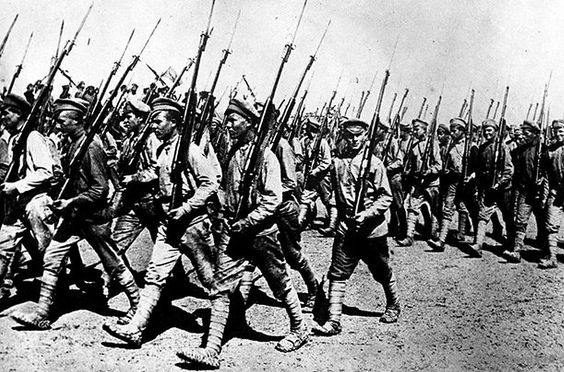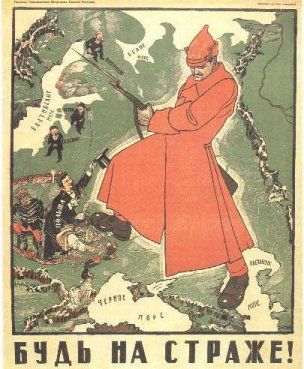The formation of the Red Guard was a critical part of the success and preservation of the new Soviet government. The idea of a standing army, however, was very contradictory to the views of Lenin and his fellow Bolsheviks, who viewed a standing an army as the feature of a “bourgeois” state. They soon realized However that if they wanted to survive, they would need a professional army to survive against both external and internal threats. The former Russian imperial army and navy, together with other imperial institutions of tsarist Russia, disintegrated after the outbreak of the Russian Revolution of 1917, so there was a need for a new fighting force. By a decree on Jan. 28, 1918, the Council of People’s Commissars created a Workers’ and Peasants’ Red Army on an all voluntary basis, Trotsky was to be put in charge of its formation and upkeep. TheRed Army was recruited exclusively from among workers and peasants and immediately faced the problem of creating a competent and reliable officers’ corps. To fix this problem, Trotsky recruited and defended the use of former tsarist officers, known as “military specialists.” While few officers identified with Soviet power, many were willing to lend their services in defense of Russia against foreign forces. This gave the new, inexperienced soviet officer core it needed. The communist government also introduced in April, universal military training. During the civil war, the Red Army saw action on a wide variety of fronts, mostly in the south and east. Relying heavily on the Imperial Army’s arsenals of weapons and drawing on food supplies and horses from the interior, it vastly outnumbered its foes. To maintain high levels of recruitment, the peasant soldiers would receive pay but more importantly, their families were guaranteed rations and assistance with farm work. This, plus literacy and political education classes, served to limit desertions and forge an esprit de corps that carried over into the years after the civil war. The army’s uniform, the long overcoat that overlapped at the front and the pointed cloth cap with red-star badge, proved to be among the civil war’s most enduring symbols.

This army was essential to the longevity and survival of the Soviet state during and after the Russian civil war, without the military new country would be almost defenseless. It wouldn’t have been able to defend its self against the whites and it would have been the end of the Bolsheviks and the Soviet state.

(This post earned a spot in “Comrade’s Corner” award from the editorial team.)
Work Cited:
Siegelbaum, Lewis. “Red Guard into Army” Soviethistory.msu.edu, http://soviethistory.msu.edu/1917-2/red-guard-into-army/. Accessed 10 Feb. 2018
“Red Army” Britannica.com, https://www.britannica.com/topic/Red-Army. Accessed 11 Feb. 2018
Wade, Rex A. (1984). Red Guards and Workers’ Militias in the Russian Revolution. Stanford, CA: Stanford University Press.


I thought this post was really interesting, and I like how you focused on the tensions between Communist ideology and the necessities at this time for growing and maintaining a state. The Soviets relied very heavily on their army, so it’s interesting to look at the beginning of it. Really interesting focus, I think you’ll be interested to continue looking at the military aspect of the Soviet Union throughout this class!
LikeLiked by 2 people
Thanks, I thought so to
LikeLike
You stick close to your sources here, and offer a cogent discussion of why Trotsky’s forging of the Read Army was so critical to the survival of the revolution. Nice.
LikeLiked by 1 person
Thank you!
LikeLiked by 1 person
I like how they got rid of the old army and then quickly realized they needed leaders for the massive amount of new soldiers they recruited so they brought some from the Imperial Army. I think it’s kinda funny. Unfortunately, some of these guys probably ended up dead in Stalin’s purges. They should’ve stayed out while they could.
LikeLike
Yeah I agree, also your right alot if not all of the officer Corps was killed during Stalin’s great purge, when he took power.
LikeLike
I think it is so interesting how the Bolsheviks realized that in order to gain and maintain power, they would have to compromise their values. It’s almost like small scale foreshadowing of how much of the original Communist Manifesto would have to be sacrificed in order for the Soviet Union to come into being.
LikeLiked by 1 person
I found it really interesting how the Bolshevik were willing to go against their traditional flow. It’s really intriguing to me to see how the party progresses in such a short span of time – I’m guessing that they need to stay on top of current topics of debate within Russian politics to stay a major political power. Of course, they do this extremely well!
LikeLiked by 1 person